Our shark and ray conservation program, also supported by a citizen science network, documents sharks and rays in catches at sea and from major fish landing sites in coastal areas. This has led to major policy wins including the uplisting of threatened sharks and rays in the Wildlife Act of Bangladesh, the development of Bangladesh’s first National Shark and Ray Conservation Strategy & Action Plan, and the development of the country’s first-ever scientific Non-Detriment Findings (NDFs) for CITES-listed sharks and rays.
Our Citizen Scientist Shark and Ray Data Collection Network engages members of coastal fishing communities to collect quantitative data and photographs of sharks and rays at fish landing sites and markets. During 14,702 visits to landing sites and markets by trained members on our network, WCS citizen scientists documented landing of 60 million sharks from 23 species, including the Critically Endangered Ganges shark and Endangered smooth hammerhead and whale sharks. The network also documented landing of 9 million rays from 51 species, several of which were previously unrecorded, including the Critically Endangered largetooth sawfish and Endangered devil rays and giant freshwater whiprays.

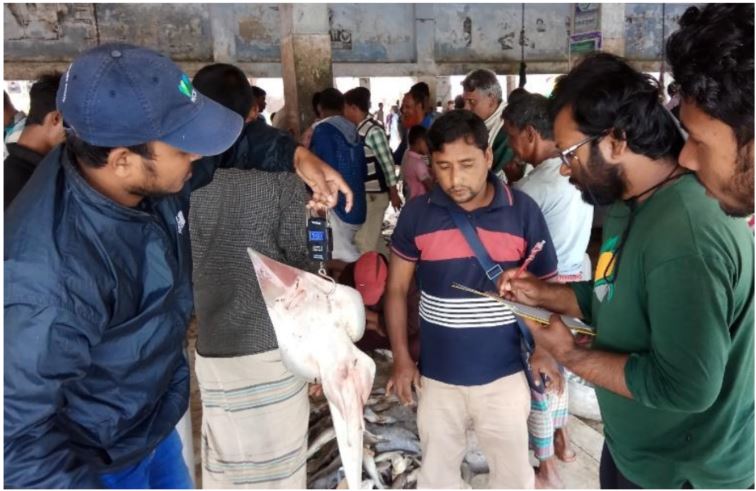
WCS Bangladesh’s citizen science team collects daily landing data on sharks and rays from nine major coastal fish landing sites across Bangladesh.
Capacity building
Across the globe illegal wildlife trade is a priority conservation concern. WCS provides technical support to the Government of Bangladesh to help ensure that local people clearly understand the laws and rules protecting marine biodiversity, including Ocean Giants, and that these laws and rules are effectively enforced. WCS works with law enforcement agencies to counter wildlife trafficking in Bangladesh. In addition to our effort to build capacity among law enforcing agencies, WCS has launched a transboundary collaborative approach including Bangladesh, India, Sri Lanka, and Pakistan to assess the baseline and understand trade in CITES listed marine species.
Our capacity building effort has engaged more than 1,000 field and mid-level officers from Bangladesh Forest Department, Department of Fisheries, Bangladesh Customs, Bangladesh Coast Guards to enable them to identify protected sharks and rays and their body parts, to be able to detect and prevent illegal wildlife trade. A major achievement has been the inclusion of marine megafauna conservation in the training curricula of Bangladesh Coast Guard new recruits, which WCS is supporting and to date trained over 700 officers.
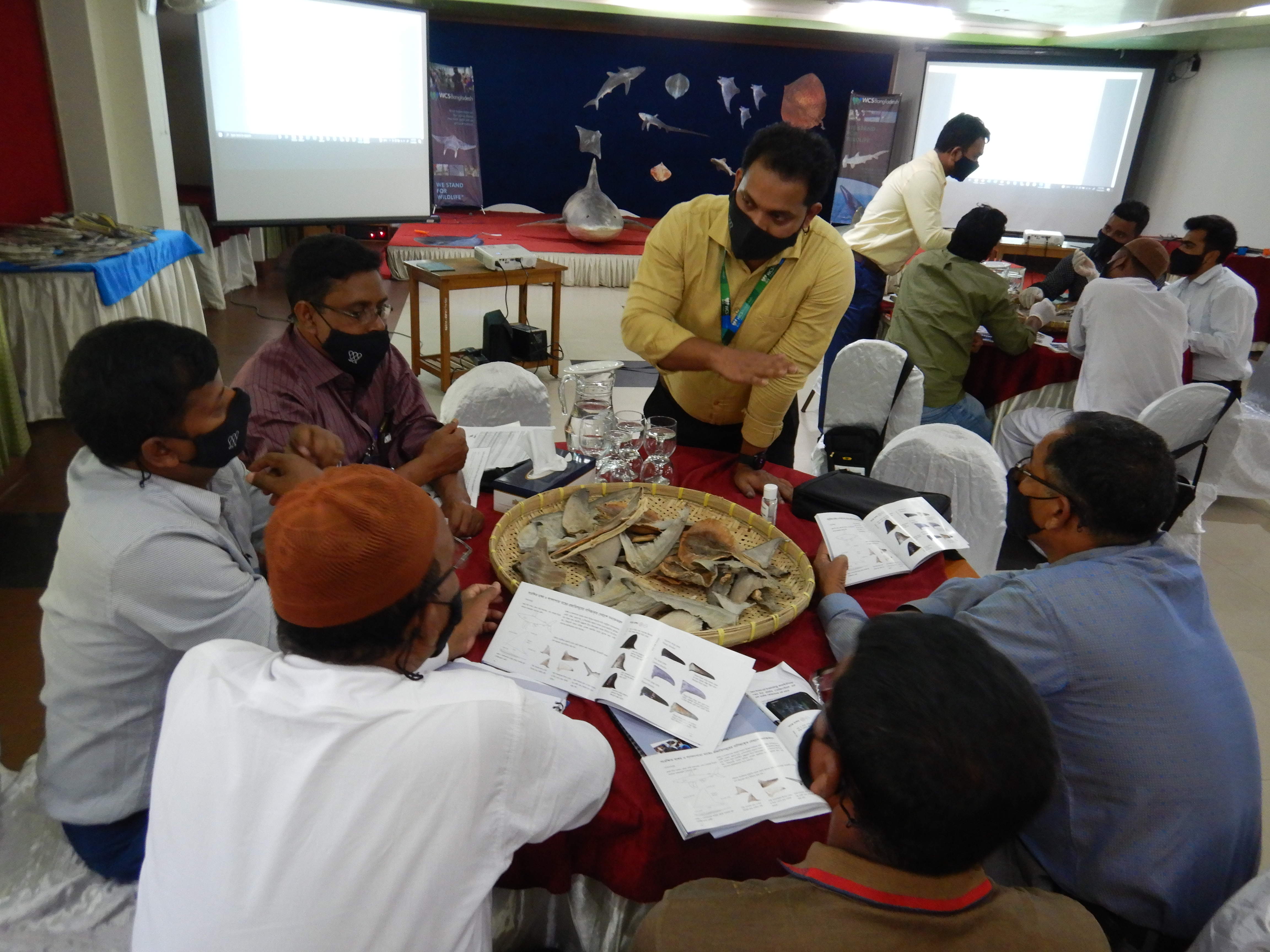
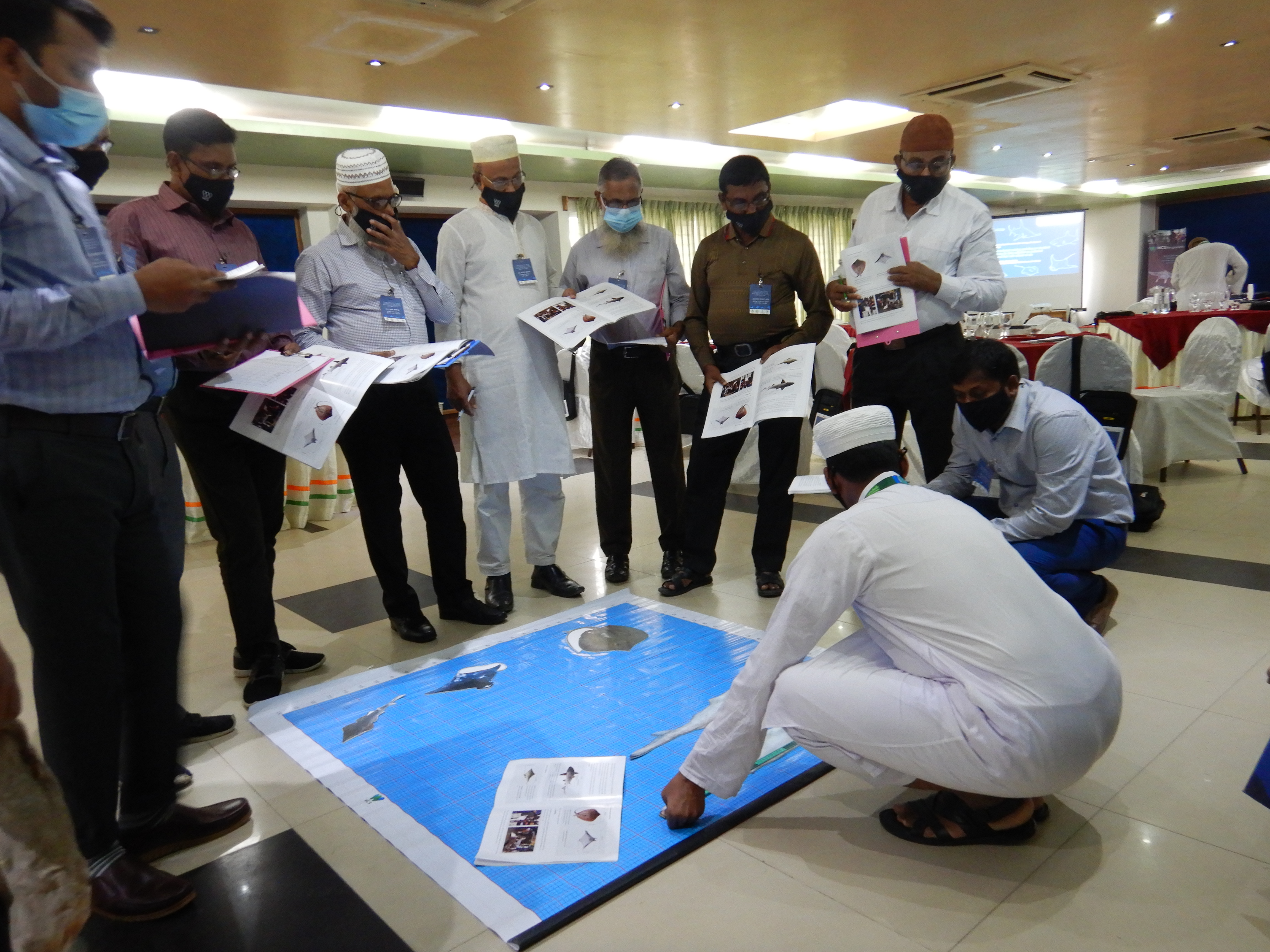
WCS Bangladesh engages law enforcement agencies and provides training to build their capacity in combating illegal marine wildlife trade in Bangladesh.
Education and awareness
Research is just the first step in sustaining a healthy ocean and healthy people. WCS is committed to sharing its discoveries with local communities and government partners and to jointly developing practical solutions to protect our country’s amazing marine biodiversity.
WCS Bangladesh convenes interactive exhibitions in coastal communities to protect threatened Ocean Giants as flagships for a healthy ocean and healthy people. Games and discussions facilitated by trained interpreters generate a deep understanding of the importance of Ocean Giants in sustaining fisheries vital for healthy coastal communities. These exhibitions build stewardship among fisherfolk and inspire visitors to become guardians and advocates for a healthy ocean and healthy people.
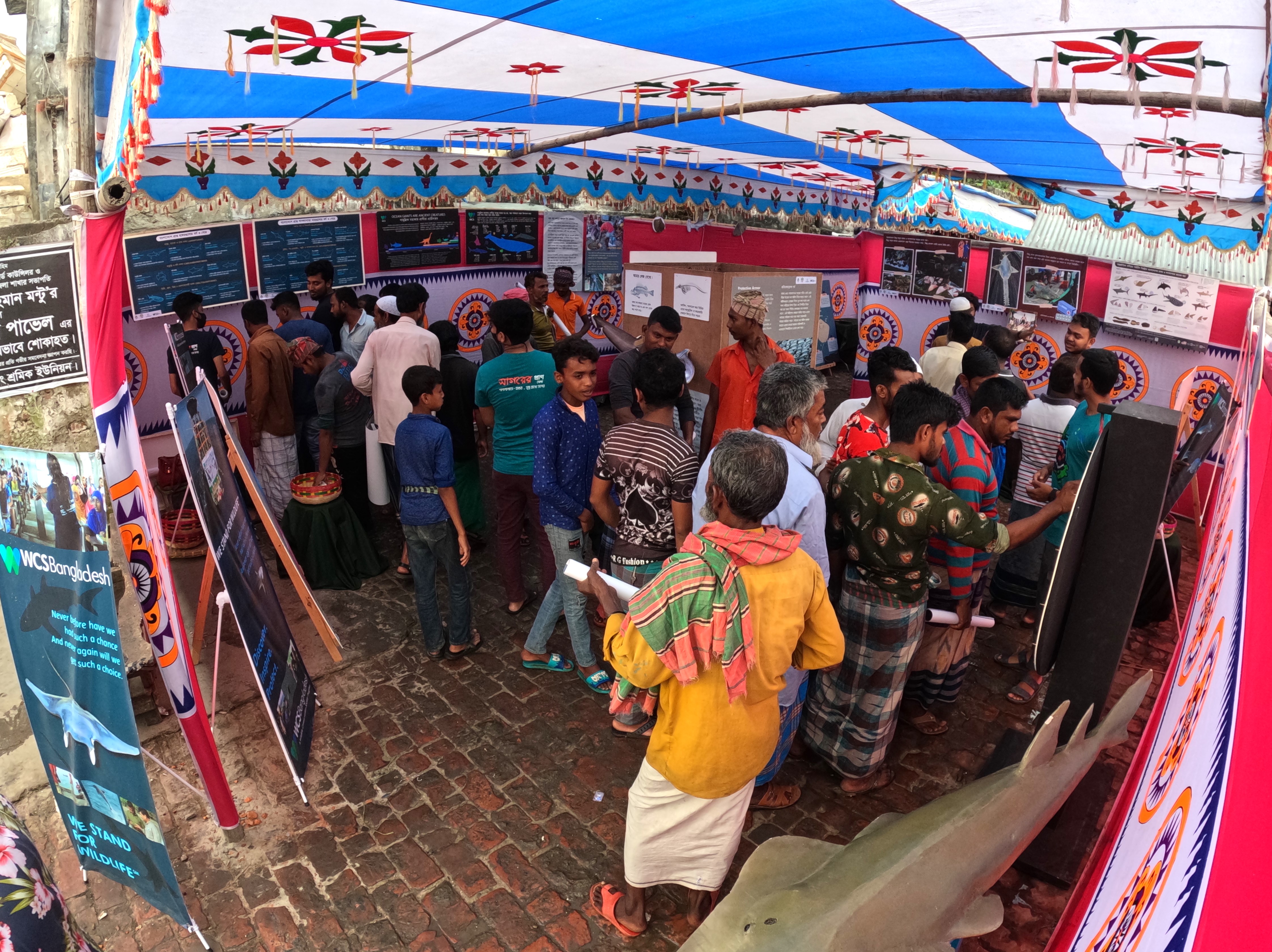
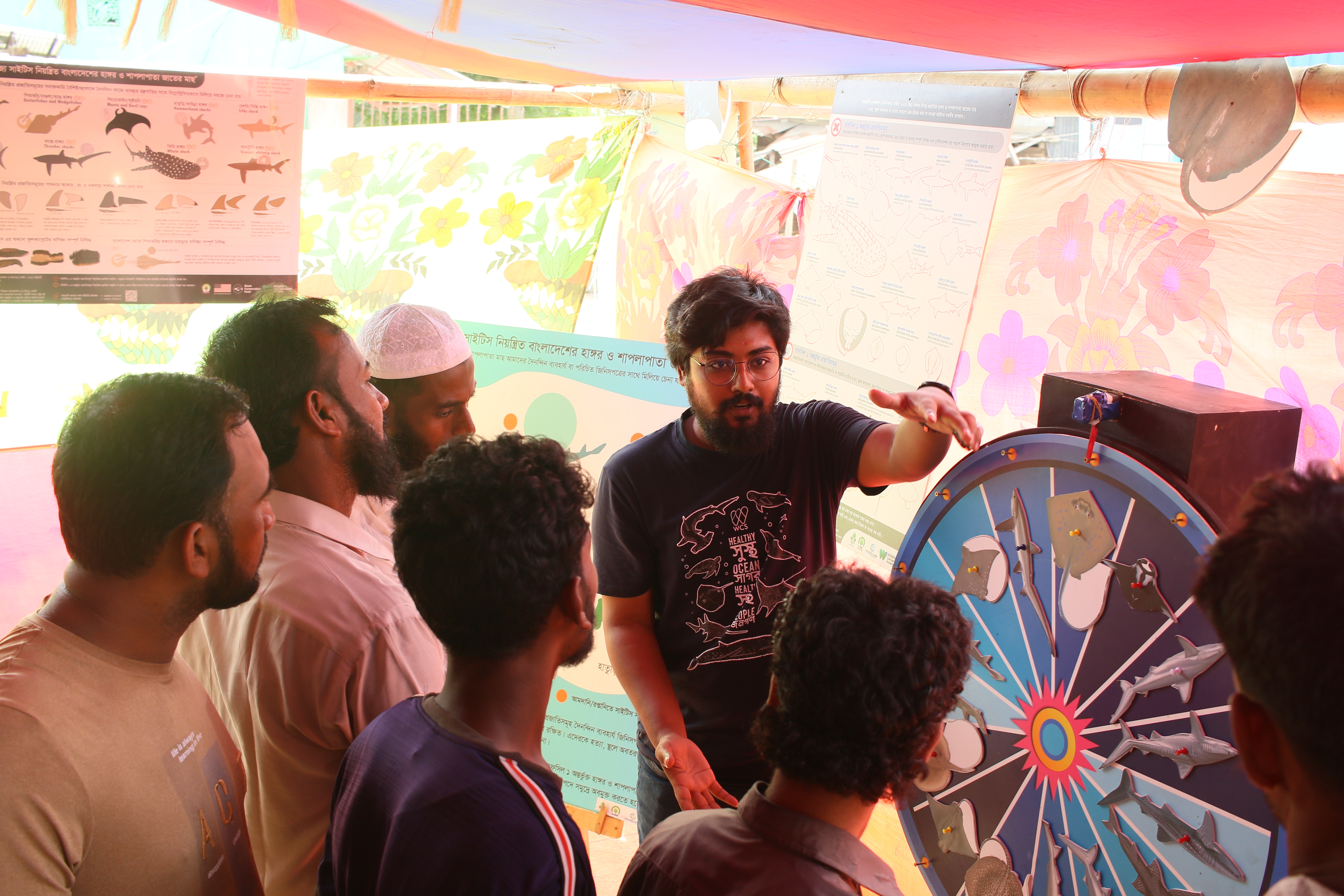
Our educational outreach exhibition engages coastal communities through guided tours led by trained interns, featuring interactive exhibits, visually compelling infographics, informative panels, and engaging fun games.
To date, our educational outreach has engaged over 110,000 coastal fishers, fish traders, their communities, local government officers through innovative exhibitions like “Ocean Guardians" and "Healthy Ocean - Healthy People (HOHP)," significantly improving knowledge of conservation laws among fishers and traders. Pre- and post-assessments conducted during HOHP exhibitions (2022–25, 220 stakeholders) showed a 35.6% increase in knowledge scores, while Ocean Guardian exhibitions (2023, 100 stakeholders) demonstrated a 45% rise.
To increase the reach of our marine education program across the coastal region WCS also trains grass-root level community facilitators from selected social service NGOs to integrate conservation messages on Ocean Giants, sustainable fisheries and marine protected areas (MPA) into their community meetings.
The citizen science approach along with the education outreach effort is inspiring fishers in safely releasing entangled threatened marine megafauna. The collaborative effort facilitated successful safe releases of threatened marine megafauna, such as the Critically Endangered Sharpnose guitarfish (Glaucostegus granulatus), Widenose guitarfish (Glaucostegus obtusus), and Endangered Whale shark (Rhincodon typus) and landing site efforts facilitated documentation of world largest sawfish records and more than 45 specimens of Ganges sharks (Glyphis gangeticus), Bigeye threshers (Alopias superciliosus), and Sharptooth lemon sharks (Negaprion acutidens).
Area-based marine management
WCS is helping to empower Bangladesh to achieve its national goal and international target under the Convention of Biological Biodiversity for establishing a network of MPAs covering 30% of the country’s marine environment by 2030. WCS understands that biodiversity protection must be balanced with the needs of millions of people who depend on a healthy ocean. That is why we advocate multi-use MPAs that are science-based and incorporate community-informed fisheries management within a larger ecosystem approach to enhance fisheries in surrounding waters and protect threatened marine biodiversity and functionally important ecosystems. To date, WCS has supported the establishment of three MPAs - the Swatch of No-Ground (SoNG), Nijhum Dwip, and Saint Martin - together covering approximately 5.7% of Bangladesh's Exclusive Economic Zone.

WCS Bangladesh supports the Government of Bangladesh in establishing and managing multi-use marine protected areas to conserve threatened marine species, sustain fisheries, and safeguard fishing livelihoods – advancing a thriving blue economy.
Additionally, we assisted the government in developing management plans for the SoNG and Nijhum Dwip MPAs. These management plans include conceptual zonation within the MPA boundaries to balance the conservation needs with the livelihoods of local communities. These were developed through a marine spatial planning (MSP) process which focused on areas for fish replenishment or spawning and nursery, marine megafauna conservation, sustainable fishing, and community-based tourism development.
Through a team of dedicated conservation biologists—and by partnering with local communities, government agencies, and other stakeholders—WCS Bangladesh balances the needs of coastal communities with protecting threatened ocean giants in Bangladesh for a Healthy Ocean supporting Healthy People. WCS Bangladesh is now focusing on expanding and strengthening MPAs, including improving management of the SoNG, Nijhum Dwip and Saint Martin MPAs, establishing a new OECM (Other Effective Area-based Conservation Measure) to connect key habitats, and developing and implementing a bycatch reduction framework. Additionally, WCS is deepening community engagement by empowering fishers, ensuring their participation in conservation decisions, and supporting alternative livelihoods in coastal communities.